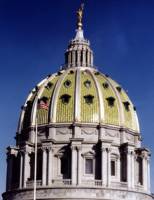Roland Hinton PerryArtist Roland Hinton Perry is the man who sculpted the statue Commonwealth on top of the Capitol's dome. Often referred to incorrectly as Ms. Penn, Commonwealth is the most visible piece of Capitol artwork as she can be seen from miles around Harrisburg. Perry was commissioned by Joseph Huston in 1904 to execute a drawing that the architect had done of this allegorical figure. Using a series of steam hoists, the bronze figure was lifted to the top on the dome and installed on May 25, 1905. According to Huston, she represents "the symbolic embodiment of the Commonwealth of Pennsylvania."The statue weighs three tons and the figure alone stands fourteen-feet-six-inches tall. Adding the large gilded ball at the base, the entire sculpture stands over eighteen feet high. Perry was a master of both painting and sculpture, and he began his studies at the Art Students' League in New York City at the age of sixteen. Three years later he traveled to Paris to study with Paul Delance at the Academie Delecluse. He entered the École des Beaux-Arts in 1890 as the only American student admitted that year. Perry remained in Paris for six years, producing both paintings and sculpture. Returning to the United States, he was commissioned to sculpt bas reliefs at the Library of Congress. He also created a frieze for the New Amsterdam Theater in New York City. Perry is also credited with two monuments at Gettysburg National Military Park — the statue of Brigadier General George Greene on Culp's Hill, and Brigadier General James Wadsworth on McPherson's Ridge. In all, Perry designed and created over thirty major pieces of art, and he continued to work prolifically until his death on October 27, 1941. |


